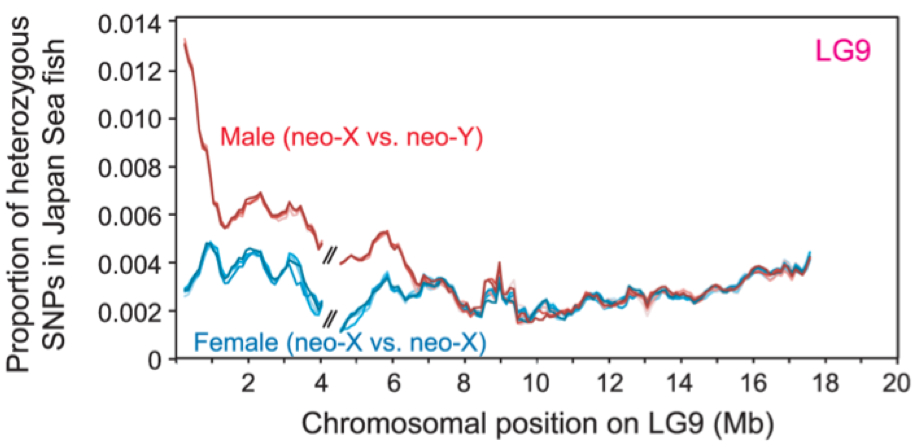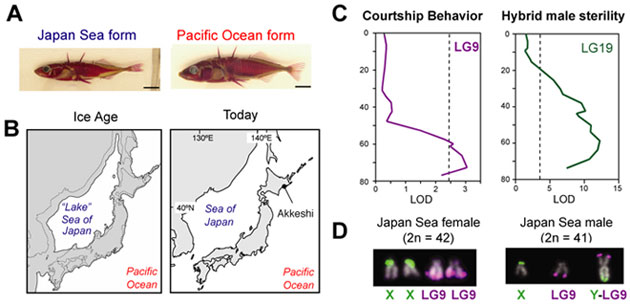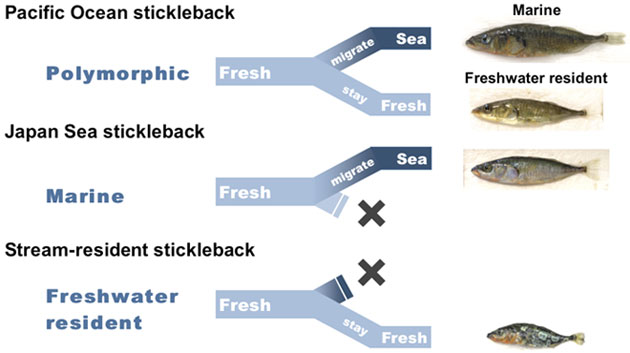RESEARCH
Our research goal
Our research goal is to identify molecular changes
underlying naturally occurring phenotypic variation and speciation and
understand how such variations arise and spread within natural
populations. Because of recent advances in genomic technologies, an
increasing number of candidate genomic loci or genes responsible for
adaptation and speciation have been identified. Molecular changes or
causative mutations, however, have been rarely elucidated in most
cases. Without knowing causative mutations, we cannot understand how
many mutations are important, whether each mutation is additive or
epistatic, or what kind of selective pressures have acted on each
mutation.
Experimental approach
To this end, we take an integrative approach across
diverse disciplines using stickleback fishes (genus Gasterosteus and Pungitius)
and medake fishes (genus Oryzias)
as models. The first step is to conduct detailed field
surveys to characterize phenotypic variation and reproductive isolation
between natural populations. Next, we use genetic and genomic
technologies to find candidate genes responsible for such variation.
Then, we use biochemical and cell culture assay to study the functions
of genetic changes in these candidate genes in vitro.
We also make
genetically engineered sticklebacks using TALEN/CRISPR technologies and
tol2-mediated transgenesis to investigate their physiological
functions in vivo. Finally, we will use semi-natural settings to
investigate how the mutant alleles behave in different environments.
Research projects
1. Driving forces and roles of sex chromosome turnover
Our studies have
revealed that some of the
important genes for adaptation and speciation are localized on sex
chromosomes. Because sex chromosomes are one of the most rapidly
evolving parts of the genome and theoretical studies predict that sex
chromosomes play important roles in the evolution of
sexually dimorphic traits and reproductive isolation, we hypothesized
that sex chromosome turnover
may promote
phenotypic diversification and speciation. We use sticklebacks and
medakas as a model to test this possibility. Our primary goal is to
identify genes and genetic alterations on young sex chromosomes that
cause speciation and the evolution of
sexually dimorphic traits. We also use computer
simulations to investigate the driving forces of sex chromosome
turnover.

2. Integration of physiology and biochemistry into ecological genomics
Our next goal is to integrate physiology and biochemistry into the ecolgoical genetics and genomics. Physiological and biochemical analysis can help us to identify candidate genes and also to undestand how genetic chnages alter fitness-related physiological traits. First, we study the biochemical mechanisms by which genetic changes in chromatin-binding proteins alter chromatin regulation between incipient species using sympatric Japan Sea sticklebac (Gasterosteus nipponicus) and Pacific Ocean threespine stickleback (Gasterosteus aculeatus). We also investigate the physiological mechanisms underlying divergence in the timing of reproduction between marine and stream ecotypes of threespine stickleback.

3. Identification of genetic changes underlying colonization of new niches
Exploitation of empty niches can trigger adaptive radiation, the
evolution of ecological and phenotypic diversity within a rapidly
multiplying lineage. One of the remarkable examples is the
diversification of sticklebacks: during the last glacial cycles, many
freshwater lakes and rivers were newly formed, and marine ancestral
sticklebacks have colonized these empty niches and diversified. Not all
lineages, however, have seized these ecological opportunities to
colonize freshwater environments. What genetic factors determine the
difference in the ability to colonize freshwater niches? In this
project, we aim to understand the genetic changes responsible for
variation in the physiological ability of freshwater colonization
between sticklebacks.

4. Conservation genetics
Because environmental disturbances are rapidly changing the ecosystem, it is increasingly important to understand the genetic and ecological mechanisms of adaptation and speciation in natural animal populations. We investigate the effects of human disturbance as well as natural disasters, such as tsunamis, on the ecology and evolution of natural stickleback populations.



